Agrivoltaics as a Sustainable Strategy to Enhance Food Security Under Water Scarcity
Abstract
1. Introduction
2. Materials and Methods
2.1. Experimental Setup and Techniques
2.2. Quantitative and Qualitative Evaluation of Chicory Biomass Production
2.3. Data Interpretation and Statistical Analysis
3. Results
3.1. Biomass Analysis
3.2. Chlorophyll and Carotenoid Content
3.3. Abiotic Variables Analysis
4. Discussion
4.1. Biomass Production and Water Saving
4.2. Differences in Photosynthetic Pigment Concentrations
4.3. The Impact of Abiotic Components
5. Conclusions
Author Contributions
Funding
Data Availability Statement
Acknowledgments
Conflicts of Interest
References
- Semeraro, T.; Scarano, A.; Curci, L.M.; Leggieri, A.; Lenucci, M.; Basset, A.; Santino, A.; Piro, G.; De Caroli, M. Shading effects in agrivoltaic systems can make the difference in boosting food security in climate change. Appl. Energy 2024, 358, 122565. [Google Scholar] [CrossRef]
- Diamond, J. Evolution, consequences and future of plant and animal domestication. Nature 2002, 418, 700e707. [Google Scholar] [CrossRef] [PubMed]
- Notarnicola, B.; Sala, S.; Assumpció, A.; McLaren, S.J.; Saouter, E.; Sonesson, U. The role of life cycle assessment in supporting sustainable agri-food systems: A review of the challenges. J. Clean. Prod. 2017, 140, 399–409. [Google Scholar] [CrossRef]
- FAO; IFAD. The State of Food Security and Nutrition in the World: Building Climate Resilience for Food Security and Nutrition. Food and Agriculture Organization of the United Nations. Rome, 2018, FAO. Available online: https://openknowledge.fao.org/server/api/core/bitstreams/f5019ab4-0f6a-47e8-85b9-15473c012d6a/content (accessed on 4 February 2025).
- Mirzabev, A.; Kerr, R.B.; Hasegawa, T.; Pradhan, P.; Wreford, A.; von der Pahlen, M.C.T.; Gurney-Smith, H. Severe climate change risks to food security and nutrition. Clim. Risk Manag. 2023, 39, 100473. [Google Scholar] [CrossRef]
- HLPE. Food Security and Nutrition: Building a Global Narrative Towards 2030. 2020. Available online: https://www.fao.org/3/ca9731en/ca9731en.pdf (accessed on 5 May 2022).
- Tilman, D.; Fargione, J.; Wolff, B.; D’Antonio, C.; Dobson, A.; Howarth, R.; Swackhamer, D. Forecasting agriculturally driven global environmental change. Science 2001, 292, 281–284. [Google Scholar] [CrossRef]
- Garnett, T. Where are the best opportunities for reducing greenhouse gas emissions in the food system (including the food chain)? Food Policy 2011, 36, S23–S32. [Google Scholar] [CrossRef]
- McMichael, A.J.; Powles, J.W.; Butler, C.D.; Uauy, R. Food, livestock production, energy, climate change, and health. Lancet 2007, 370, 1253e1263. [Google Scholar] [CrossRef]
- Toniolo, S.; Russo, I.; Bravo, I. Integrating product-focused life cycle perspectives in the fresh food supply chain: Revealing intra- and inter-organizational views. Sustain. Prod. Consum. 2024, 48, 46–61. [Google Scholar] [CrossRef]
- Mehran, A.; AghaKouchak, A.; Nakhjiri, N.; Stewardson, M.J.; Peel, M.C.; Phillips, T.J.; Wada, Y.; Ravalico, J.K. Compounding Impacts of Human-Induced Water Stress and Climate Change on Water Availability. Sci. Rep. 2017, 7, 6282. [Google Scholar] [CrossRef]
- United Nations. World Population Projected to Reach 9.8 Billion in 2050, and 11.2 Billion in 2100. Department of Economic and Social Affairs. 2024. Available online: https://www.un.org/tr/desa/world-population-projected-reach-98-billion-2050-and-112-billion-2100 (accessed on 4 February 2025).
- Semeraro, T.; Scarano, A.; Leggieri, A.; Calisi, A.; De Caroli, M. Impact of Climate Change on Agroecosystems and Potential Adaptation Strategies. Land 2023, 12, 1117. [Google Scholar] [CrossRef]
- Stian, B.H.; Erling, M. Natural capital in integrated assessment models of climate change. Ecol. Econ. 2015, 116, 354–361. [Google Scholar] [CrossRef]
- Willis, K.J.; Bhagwat, S.A. Biodiversity and climate change. Science 2009, 326, 806–807. [Google Scholar] [CrossRef] [PubMed]
- Filho, W.L.; Nagy, G.J.; Setti, A.F.F.; Sharifi, A.; Donkor, F.K.; Batista, K.; Djekic, I. Handling the impacts of climate change on soil biodiversity. Sci. Total Environ. 2023, 869, 161671. [Google Scholar] [CrossRef] [PubMed]
- Kamboj, R.; Kamboj, S.; Kamboj, S.; Kriplani, P.; Dutt, R.; Guarve, K.; Grewal, A.S.; Srivastav, A.L.; Gautam, S.P. Chapter 1-Climate uncertainties and biodiversity: An overview. In Visualization Techniques for Climate Change with Machine Learning and Artificial Intelligence; Srivastav, A., Dubey, A., Kumar, A., Kumar Narang, S., Ali Khan, M., Eds.; Elsevier: Amsterdam, The Netherlands, 2023; pp. 1–14. ISBN 9780323997140. [Google Scholar] [CrossRef]
- Hopkins, W.G.; Huner, N.P.A. Introduction to Plant Physiology; John Wiley & Sons, Inc.: Hoboken, NJ, USA, 2004; ISBN 978-0-470-24766-2. [Google Scholar]
- Costanza, R.; Fisher, B.; Mulder, K.; Liu, S.; Christopher, T. Biodiversity and ecosystem services: A multi-scale empirical study of the relationship between species richness and net primary production. Ecol. Econ. 2007, 61, 478–491. [Google Scholar] [CrossRef]
- Semeraro, T.; Mastroleo, G.; Pomes, P.; Luvisi, A.; Gissi, E.; Aretano, R. Modelling Fuzzy combination of remote sensing vegetation index for durum wheat crop analysis. Comput. Electron. Agric. 2019, 156, 684–692. [Google Scholar] [CrossRef]
- Semeraro, T.; Luvisi, A.; Lillo, A.; Aretano, R.; Buccolieri, R.; Marwan, N. Recurrence Analysis of Vegetation Indices for Highlighting the Ecosystem Response to Drought Events: An Application to the Amazon Forest. Remote Sens. 2020, 12, 907. [Google Scholar] [CrossRef]
- Lakhiar, I.A.; Yan, H.; Zhang, C.; Zhang, J.; Wang, G.; Deng, S.; Syed, T.N.; Wang, B.; Zhou, R. A review of evapotranspiration estimation methods for climate-smart agriculture tools under a changing climate: Vulnerabilities, consequences, and implications. J. Water Clim. Change 2025, 16, 249–288. [Google Scholar] [CrossRef]
- Lakhiar, I.A.; Yan, H.; Zhang, J.; Wang, G.; Deng, S.; Bao, R.; Zhang, C.; Syed, T.N.; Wang, B.; Zhou, R.; et al. Plastic Pollution in Agriculture as a Threat to Food Security, the Ecosystem, and the Environment: An Overview. Agronomy 2024, 14, 548. [Google Scholar] [CrossRef]
- Mancosu, N.; Snyder, R.L.; Kyriakakis, G.; Spano, D. Water Scarcity and Future Challenges for Food Production. Water 2015, 7, 975–992. [Google Scholar] [CrossRef]
- FAO. World Agriculture, Towards 2030/2050. FAO, Rome. 2006. Available online: http://www.fao.org/fileadmin/user_upload/esag/docs/Interim_report_AT2050web.pdf (accessed on 4 February 2025).
- FAO. Livestock Environmental Assessment and Performance (LEAP) Partnership. 2015. Available online: http://www.fao.org/partnerships/leap/en/ (accessed on 4 February 2025).
- Lakhiar, I.A.; Yan, H.; Zhang, C.; Wang, G.; He, B.; Hao, B.; Han, Y.; Wang, B.; Bao, R.; Syed, T.N.; et al. A Review of Precision Irrigation Water-Saving Technology under Changing Climate for Enhancing Water Use Efficiency, Crop Yield, and Environmental Footprints. Agriculture 2024, 14, 1141. [Google Scholar] [CrossRef]
- Soussana, J.F. Research priorities for sustainable agri-food systems and life––cycle assessment. J. Clean. Prod. 2014, 73, 19e23. [Google Scholar] [CrossRef]
- Dixon, G.R. Chapter 17-The Impact of Climate and Global Change on Crop Production. In Climate Change Observed Impacts on Planet Earth; Letcher, T.M., Ed.; Elsevier: Amsterdam, The Netherlands, 2009; pp. 307–324. [Google Scholar] [CrossRef]
- Habib-ur-Rahman, M.; Ahmad, A.; Raza, A.; Hasnain, M.U.; Alharby, H.F.; Alzahrani, Y.M.; Bamagoos, A.A.; Hakeem, K.R.; Ahmad, S.; Nasim, W.; et al. Impact of climate change on agricultural production; Issues, challenges, and opportunities in Asia. Front. Plant Sci. 2022, 13, 925548. [Google Scholar] [CrossRef]
- Scharff, L.B.; Saltenis, V.L.R.; Jenen, P.E.; Baekelandt, A.; Burgess, A.J.; Burow, M.; Ceriotti, A.; Cohan, J.-P.; Geu-Flores, F.; Halkien, B.A.; et al. Prospects to improve nutritional quality of crops. Food Energy Secur. 2021, 11, e327. [Google Scholar] [CrossRef]
- Wu, J.; Wang, J.; Hui, W.; Zhao, F.; Wang, P.; Su, C.; Gong, W. Physiology of Plant Responses to Water Stress and Related Genes: A Review. Forests 2022, 13, 324. [Google Scholar] [CrossRef]
- Williams, H.J.; Wang, Y.; Yuan, B.; Wang, H.; Zhang, K.M. Rethinking agrivoltaic incentive programs: A science-based approach to encourage practical design solutions. Appl. Energy 2025, 377, 124272. [Google Scholar] [CrossRef]
- Amaducci, S.; Yin, X.; Colauzzi, M. Agrivoltaic systems to optimise land use for electric energy production. Appl. Energy 2018, 220, 545–561. [Google Scholar] [CrossRef]
- Dinesh, H.; Pearce, J.M. The potential of agrivoltaic systems. Renew. Sustain. Energy Rev. 2016, 54, 299–308. Available online: http://linkinghub.elsevier.com/retrieve/pii/S136403211501103X (accessed on 12 October 2024). [CrossRef]
- Rezazadeh, A.; Harkess, R.; Telmadarrehei, T. The Effect of Light Intensity and Temperature on Flowering and Morphology of Potted Red Firespike. Horticulturae 2018, 4, 36. [Google Scholar] [CrossRef]
- Scarano, A.; Semeraro, T.; Calisi, A.; Aretano, R.; Rotolo, C.; Lenucci, M.S.; Santino, A.; Piro, G.; De Caroli, M. Effects of the Agrivoltaic System on Crop Production: The Case of Tomato (Solanum lycopersicum L.). Appl. Sci. 2024, 14, 3095. [Google Scholar] [CrossRef]
- Paschalis, A.; Bonetti, S.; Fatichi, S. Controls of ecohydrological grassland dynamics in agrivoltaic systems. Earth’s Future 2025, 13, e2024EF005183. [Google Scholar] [CrossRef]
- De Francesco, C.; Centorame, L.; Toscano, G.; Duca, D. Opportunities, Technological Challenges and Monitoring Approaches in Agrivoltaic Systems for Sustainable Management. Sustainability 2025, 17, 634. [Google Scholar] [CrossRef]
- Omer, A.A.A.; Liu, W.; Li, M.; Zheng, J.; Zhang, F.; Zhang, X.; Mohammed, S.O.H.; Fan, L.; Liu, Z.; Chen, F.; et al. Water evaporation reduction by the agrivoltaic systems development. Sol. Energy 2022, 247, 13–23. [Google Scholar] [CrossRef]
- Randle-Boggis, R.; Barron-Gafford, G.; Kimaro, A.; Lamanna, C.; Macharia, C.; Maro, J.; Mbele, A.; Hartley, S. Harvesting the sun twice: Energy, food and water benefits from agrivoltaics in East Africa. Renew. Sustain. Energy Rev. 2025, 208, 115066. [Google Scholar] [CrossRef]
- Schweiger, A.H.; Pataczek, L. How to reconcile renewable energy and agricultural production in a drying world. Plants People Planet 2023, 5, 650–661. [Google Scholar] [CrossRef]
- Ministry of the Environment and Energy Security. Guidelines on Agrivoltaic Systems. 2022. Available online: https://www.mase.gov.it/notizie/impianti-agri-voltaici-pubblicate-le-linee-guida (accessed on 4 February 2025).
- UNI. Agri-Voltaic Systems-Integration of Agricultural Activities and Photovoltaic Implants. UNI/PdR 148:2023. 2023. Available online: https://new.contentocms.net/uploads/levantesw.it/files/PDR14000805316.pdf (accessed on 4 February 2025).
- Protezione Civile of the Puglia Region. Available online: http://93.57.89.4:8081/temporeale/meteo/stazioni?codstaz=492 (accessed on 25 June 2021).
- De Caroli, M.; Rampino, P.; Pecatelli, G.; Girelli, C.R.; Fanizzi, F.P.; Piro, G.; Lenucci, M.S. Expression of Exogenous GFP-CesA6 in Tobacco Enhances Cell Wall Biosynthesis and Biomass Production. Biology 2022, 11, 1139. [Google Scholar] [CrossRef]
- Lichtenthaler, H.K.; Buschmann, C. Chlorophylls and Carotenoids: Measurement and Characterization by UV-VIS Spectroscopy. Curr. Prot. Food Analyt. Chem. 2001, 1, 109. [Google Scholar] [CrossRef]
- Howell, D. Statistical Methods for Psychology; PWS-Kent Publishing Co.: Duxbury, MA, USA, 2002; pp. 324–325. [Google Scholar]
- Ross, A.; Willson, V.L. One-Way Anova. In Basic and Advanced Statistical Tests; SensePublishers: Rotterdam, The Netherlands, 2017. [Google Scholar] [CrossRef]
- Sthle, L.; Wold, S. Analysis of variance (ANOVA). Chemom. Intell. Lab. 1989, 6, 259–272. [Google Scholar] [CrossRef]
- Shapiro, S.S.; Wilk, M.B. An analysis of variance test for normality (complete samples). Biometrika 1965, 52, 591–611. [Google Scholar] [CrossRef]
- Zimmermann, D.W. A note on preliminary tests of equality of variances. Br. J. Math. Stat.Psychol. 2004, 57, 173–178. [Google Scholar] [CrossRef]
- Tukey, J. Comparing individual means in the Analysis of Variance. Biometrics 1949, 5, 99–114. [Google Scholar] [CrossRef]
- Tabachnick, B.G.; Fidell, L.S. Using Multivariate Statistics, 5th ed.; Pearson Education: Boston, MA, USA, 2007. [Google Scholar]
- Miller, G.A.; Chapman, J.P. Misunderstanding Analysis of Covariance. J. Abnorm. Psychol. 2001, 110, 40–48. [Google Scholar] [CrossRef] [PubMed]
- Hazrati, S.; Tahmasebi-Sarvestani, Z.; Modarres-Sanavy, S.A.M.; Mokhtassi-Bidgoli, A.; Nicola, S. Effects of water stress and light intensity on chlorophyll fluorescence parameters and pigments of Aloe vera L. Plant Physiol. Biochem. 2016, 106, 141–148. [Google Scholar] [CrossRef] [PubMed]
- Elango, T.; Jeyaraj, A.; Dayalan, H.; Arul, S.; Govindasamy, R.; Prathap, K.; Li, X. Influence of shading intensity on chlorophyll, carotenoid and metabolites biosynthesis to improve the quality of green tea: A review. Energy Nexus 2023, 12, 2772–4271. [Google Scholar] [CrossRef]
- Luo, T.; Young, R.; Reig, P. Aqueduct projected water stress rankings. In Technical Note; World Resources Institute: Washington, DC, USA, 2015; Available online: https://www.wri.org/data (accessed on 20 June 2024).
- Annual 2024 Global Climate Report. Temperature Anomalies Time Series. Available online: https://www.ncei.noaa.gov/access/monitoring/monthly-report/global/202313 (accessed on 10 July 2024).
- Pataczek, L.; Weselek, A.; Bauerle, A.; Högy, P.; Lewandowski, I.; Zikeli, S.; Schweiger, A. Agrivoltaics mitigate drought effects in winter wheat. Physiol. Plant. 2023, 175, e14081. [Google Scholar] [CrossRef]
- Hickey, T.; Uchanski, M.; Bousselot, J. Vegetable crop growth under photovoltaic (PV) modules of varying transparencies. Heliyon 2024, 10, e36058. [Google Scholar] [CrossRef]
- Berrian, D.; Chhapia, G.; Linder, J. Performance of land productivity with single-axis trackers and shade-intolerant crops in agrivoltaic systems. Appl. Energy 2025, 384, 125471. [Google Scholar] [CrossRef]
- Veneto agricoltura. La Gestione Efficiente Dell’acqua in Agricoltura. 2023. Available online: https://www.venetoagricoltura.org/wp-content/uploads/2023/09/Sambo_Acqua-e-orticoltura.pdf (accessed on 4 February 2025).
- Milly, P.; Dunne, K.; Vecchia, A. Global pattern of trends in streamflow and water availability in a changing climate. Nature 2005, 438, 347–350. [Google Scholar] [CrossRef]
- Oki, T.; Kanae, S. Global hydrological cycles and world water resources. Science 2006, 313, 1068–1072. [Google Scholar] [CrossRef]
- Konapala, G.; Mishra, A.K.; Wada, Y.; Mann, M. Climate change will affect global water availability through compounding changes in seasonal precipitation and evaporation. Nat. Commun. 2020, 11, 3044. [Google Scholar] [CrossRef]
- Agathokleous, E.; Feng, Z.; Peñuelas, J. Chlorophyll hormesis: Are chlorophylls major components of stress biology in higher plants? Sci. Tot. Environ. 2020, 726, 138637. [Google Scholar] [CrossRef]
- Croft, H.; Chen, J.M.; Luo, X.; Bartlett, P.; Chen, B.; Staebler, R.M. Leaf chlorophyll content as a proxy for leaf photosynthetic capacity. Glob. Chang. Biol. 2017, 23, 3513–3524. [Google Scholar] [CrossRef] [PubMed]
- Croft, H.; Chen, J.M.; Zhang, Y.; Simic, A. Modelling leaf chlorophyll content in broadleaf and needle leaf canopies from ground, CASI, Landsat TM 5 and MERIS reflectance data. Remote Sens. Environ. 2013, 133, 128–140. [Google Scholar] [CrossRef]
- Li, Y.; He, N.; Hou, J.; Xu, L.; Liu, C.; Zhang, J.; Wang, Q.; Zhang, X.; Wu, X. Factors Influencing Leaf Chlorophyll Content in Natural Forests at the Biome Scale. Front. Ecol. Evol. 2018, 6, 64. [Google Scholar] [CrossRef]
- Bonne, J.R.; Krauss, R.W. The Photosynthetic Response to a Shift in the Chlorophyll a to Chlorophyll b Ratio of Chlorella. Plant Physiol. 1970, 46, 568–575. [Google Scholar] [CrossRef]
- de Oliveira, M.M.T.; Albano-Machado, F.G.; Penha, D.M.; Pinho, M.M.; Natale, W.; de Miranda, M.R.A.; Moura, C.F.H.; Alves, R.E.; Corrêa, M.C.d.M. Shade improves growth, photosynthetic performance, production and postharvest quality in red pitahaya (Hylocereus costaricensis). Sci. Hortic. 2021, 286, 110217. [Google Scholar] [CrossRef]
- Global Climate Report, 2024 [AA.VV 01/12/2024]. Available online: https://www.ncei.noaa.gov/access/monitoring/monthly-report/global/202413 (accessed on 1 December 2024).
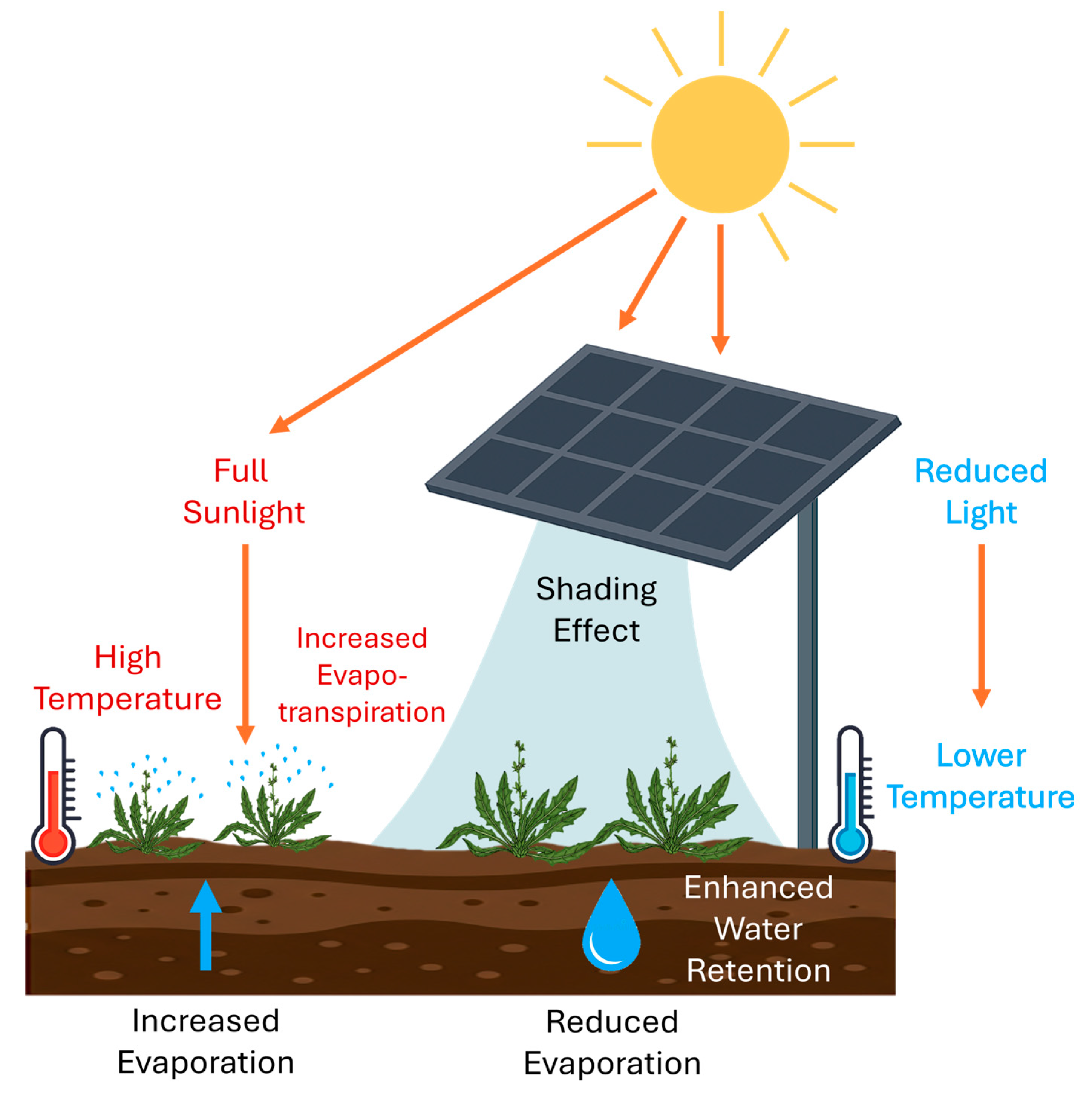



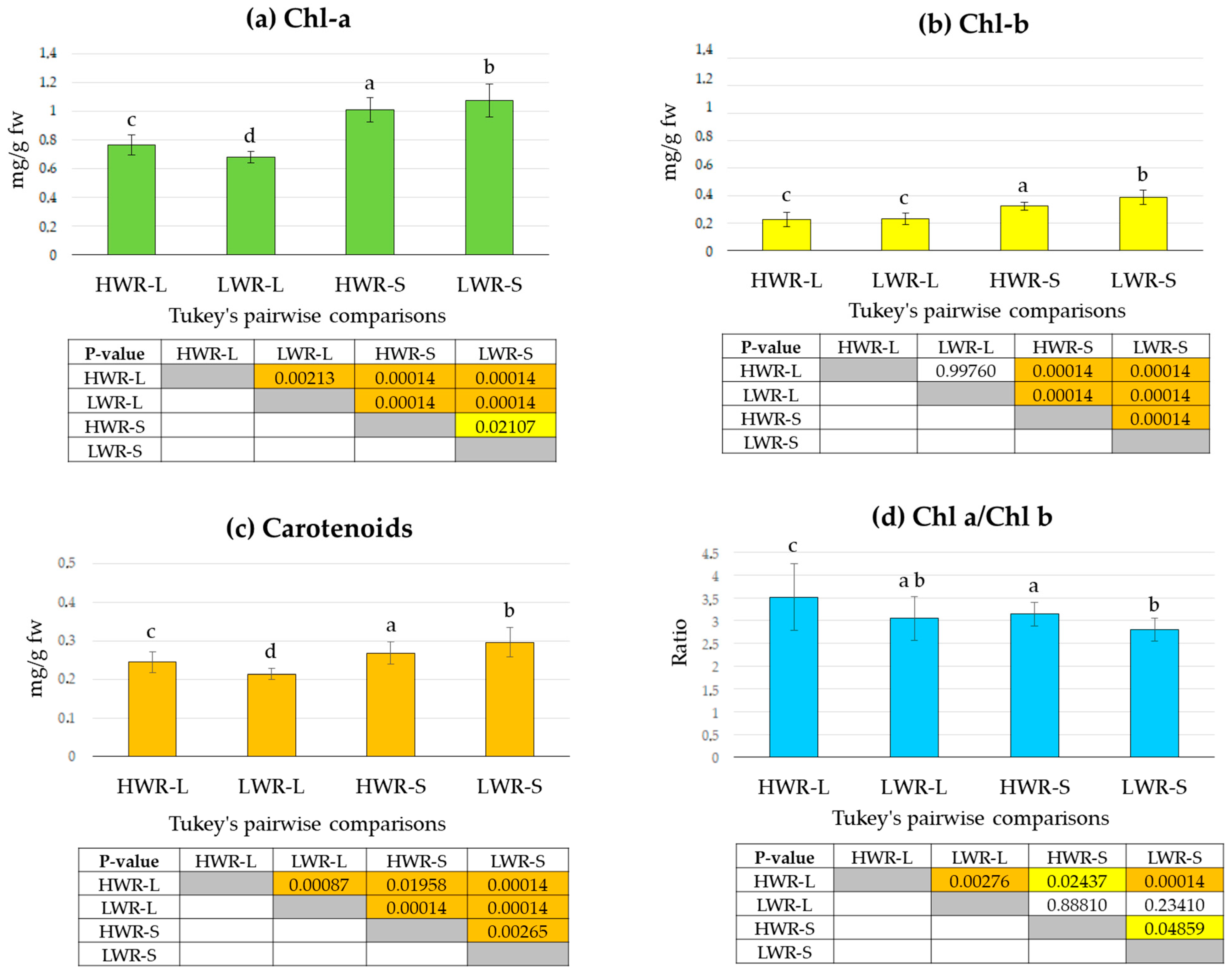

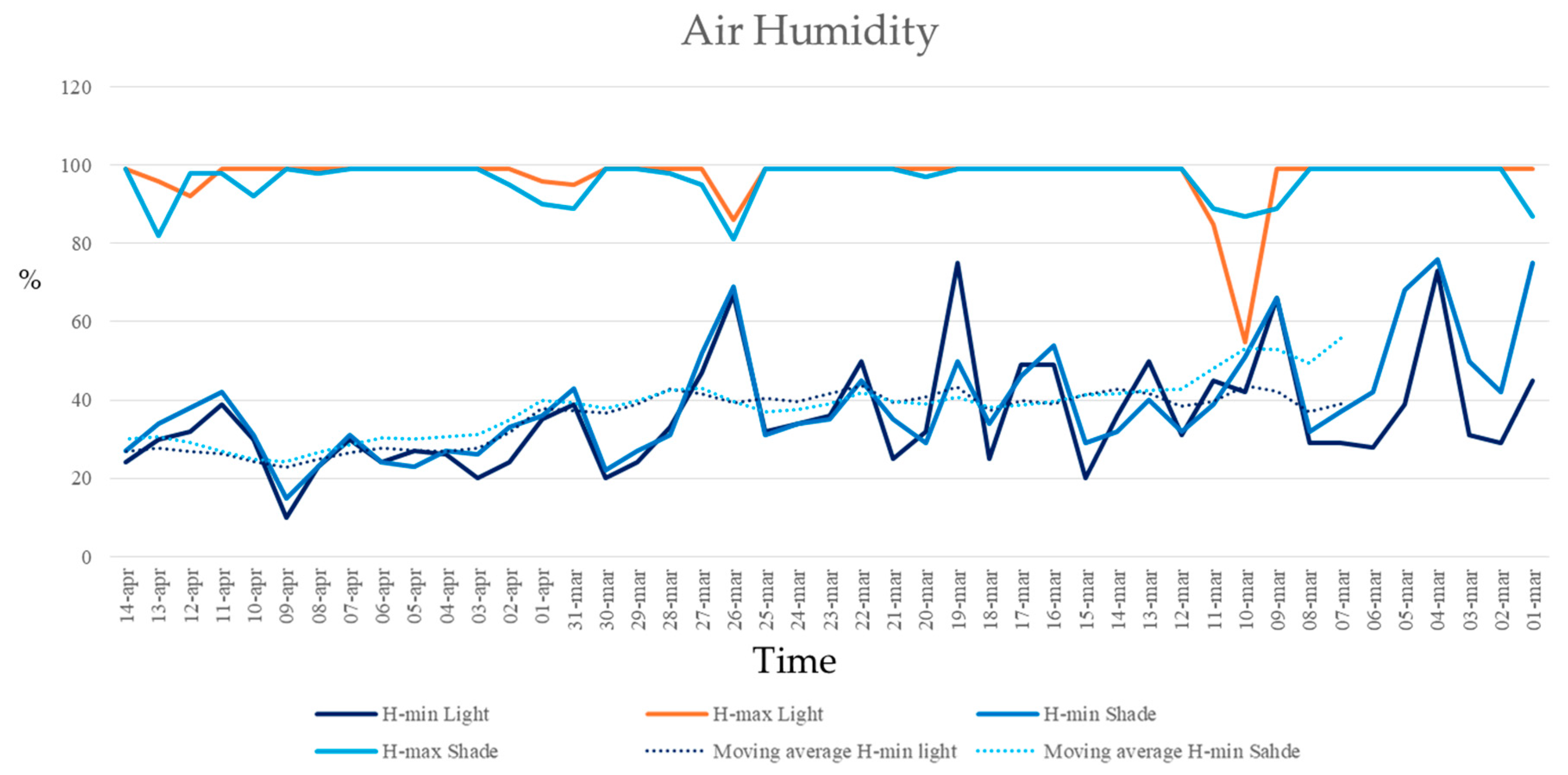
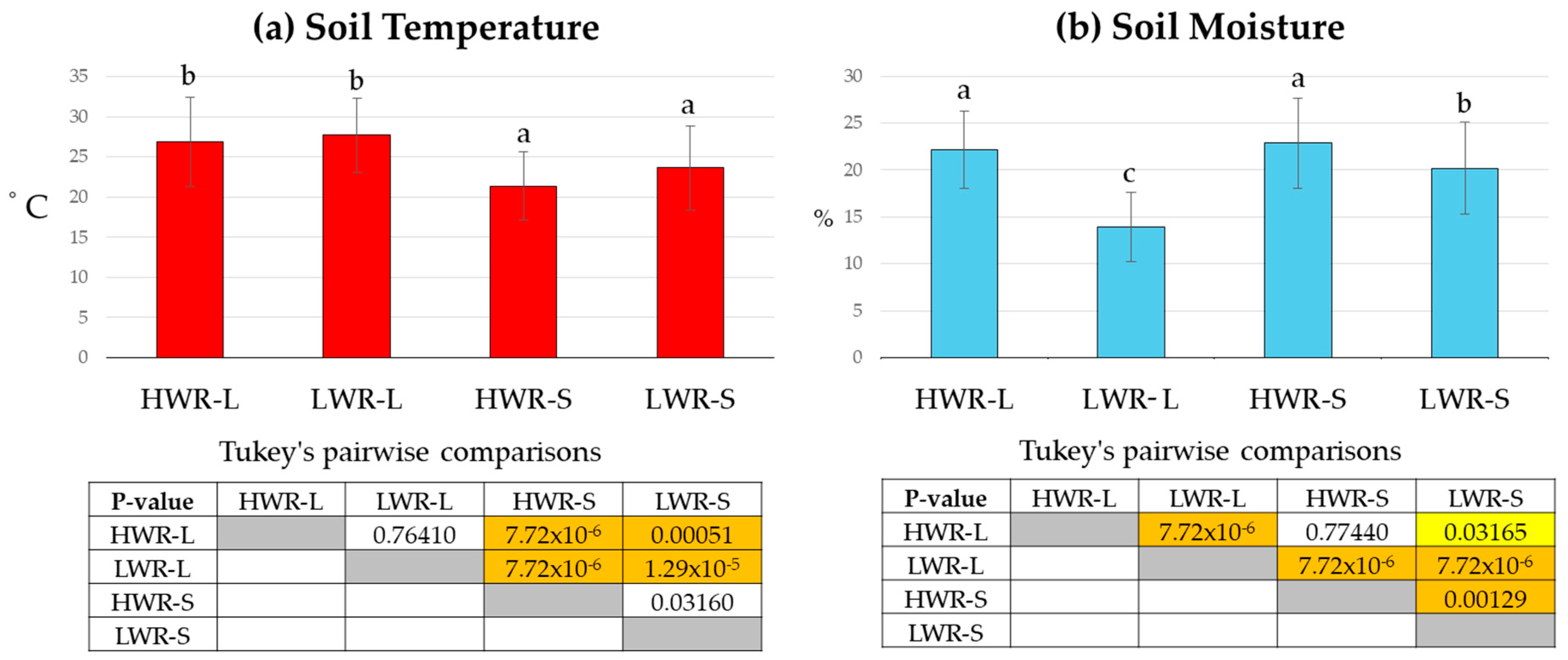
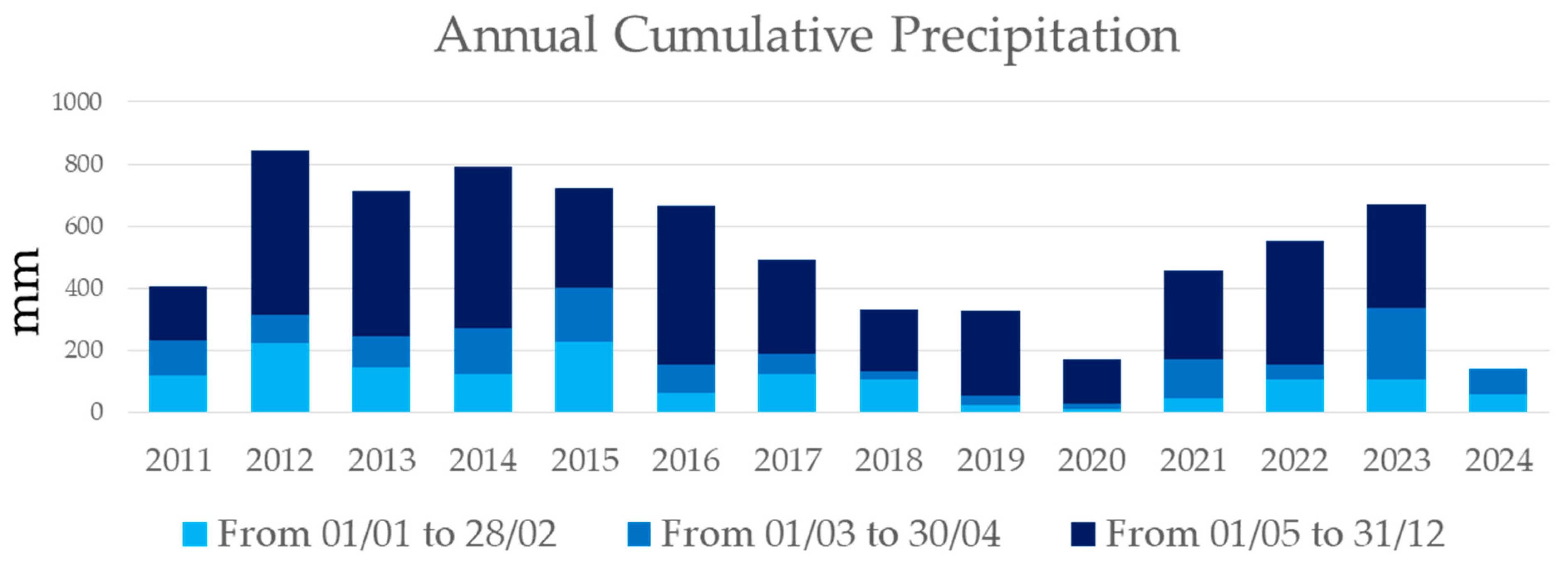
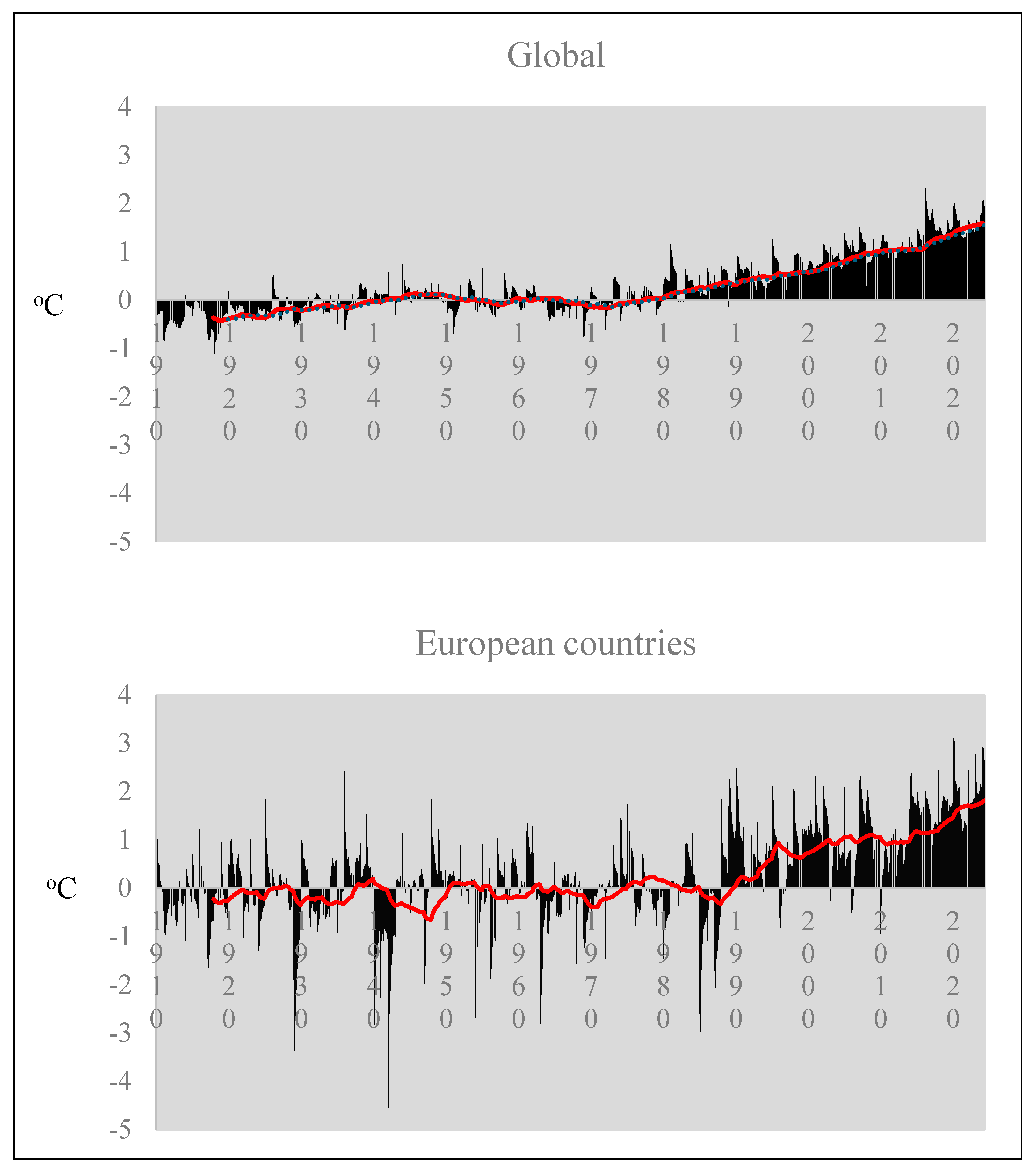
| Plot (Light Conditions) | Groups (Watering Regime) | Plant Number | Denomination |
|---|---|---|---|
| FULL SUNLIGHT (L) | High Water Regime (HWR) | 9 | HWR-L |
| Low Water Regime (LWR) | 9 | LWR-L | |
| SHADE (S) | High Water Regime (HWR) | 9 | HWR-S |
| Low Water Regime (LWR) | 9 | LWR-S |
Disclaimer/Publisher’s Note: The statements, opinions and data contained in all publications are solely those of the individual author(s) and contributor(s) and not of MDPI and/or the editor(s). MDPI and/or the editor(s) disclaim responsibility for any injury to people or property resulting from any ideas, methods, instructions or products referred to in the content. |
© 2025 by the authors. Licensee MDPI, Basel, Switzerland. This article is an open access article distributed under the terms and conditions of the Creative Commons Attribution (CC BY) license (https://creativecommons.org/licenses/by/4.0/).
Share and Cite
Scarano, A.; Curci, L.M.; Semeraro, T.; Calisi, A.; Lenucci, M.S.; Santino, A.; Basset, A.; De Caroli, M. Agrivoltaics as a Sustainable Strategy to Enhance Food Security Under Water Scarcity. Horticulturae 2025, 11, 401. https://doi.org/10.3390/horticulturae11040401
Scarano A, Curci LM, Semeraro T, Calisi A, Lenucci MS, Santino A, Basset A, De Caroli M. Agrivoltaics as a Sustainable Strategy to Enhance Food Security Under Water Scarcity. Horticulturae. 2025; 11(4):401. https://doi.org/10.3390/horticulturae11040401
Chicago/Turabian StyleScarano, Aurelia, Lorenzo Maria Curci, Teodoro Semeraro, Antonio Calisi, Marcello Salvatore Lenucci, Angelo Santino, Alberto Basset, and Monica De Caroli. 2025. "Agrivoltaics as a Sustainable Strategy to Enhance Food Security Under Water Scarcity" Horticulturae 11, no. 4: 401. https://doi.org/10.3390/horticulturae11040401
APA StyleScarano, A., Curci, L. M., Semeraro, T., Calisi, A., Lenucci, M. S., Santino, A., Basset, A., & De Caroli, M. (2025). Agrivoltaics as a Sustainable Strategy to Enhance Food Security Under Water Scarcity. Horticulturae, 11(4), 401. https://doi.org/10.3390/horticulturae11040401












